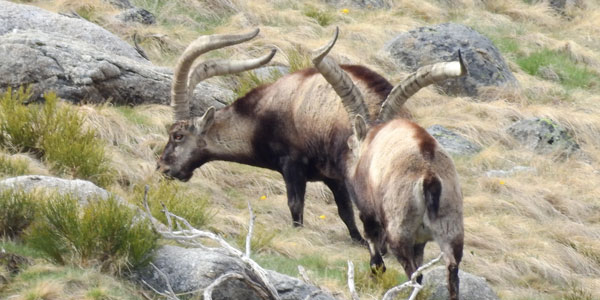
30 Jul All you have to know before hunting the Spanish Ibex.
The Spanish Ibex, 1 of the 14 species of Big Game you can hunt in Spain.
A bit of History…
When the Romans arrived at the Iberian Peninsula “Hispania” more than 2.000 years ago they find a country full of trees.
A Roman’s Tale said “in Iberia a squirrel can cross the whole country since the Mediterranean sea until the Atlantic sea jumping from a tree to another one”…
Later in the story, due to the war by the increased invasion of the Muslims and the needs to develop a Great Army to fight on the ground and on the oceans with other countries, the fighting with the pirates and also by the great challenge of the discovery and colonization of the American Continent, the Spanish people started knocking down thousands and thousands of trees for centuries, forming a new landscape and producing more meadows and steppes than forests.
The Iberian Peninsula has been in any case a huge area for the Wild Life, especially due to his nice mountain systems, with a big number of animals even if the Country has suffered Big Ecologist Disasters, main part of them make by the Human as you can see easily.
Never the less, in this Huge Wild Area that represents now the Spanish Country it is possible to find 14 different species as Big Game including the always desirable Spanish Ibex.
What happened to the Spanish Ibex? And what is his destination?
These goats have suffered several big problems and sometimes have been close to disappearing.
In fact some of the subspecies catalogued in the end of the eighteen century like the Capra Pyrenaica Lusitanica disappearing completely on the beginning of the nineteen century, and their cousin the Bucardo (Capra pyrenaica pyrenaica) disappearing as well not far away, in the 90’s.
During the twenty century we have got several big crisis, especially with the Gredos Ibex that in 1925 counted only with 25 heads, and with the South East Ibex that during the 70’s they suffered a great pandemic (epizootic), leading some isolated populations towards their total extinction, like happened in the Sierra de Cazorla Hunting Reserve.
Thanks to the huge high reproductive capacity and their great capacity for survival even in the worst conditions, these populations have recovered surprisingly.
To have an idea in the 70’s some 30 specimens were introduced in a Valley in Guadarrama Mountains, currently the population has more than 5000 heads.
Now the problems are not coming from the pandemic disease, but because of the restrictions of the Green People that wants to ban at 100% of their hunt.
This situation is creating a big problem, since this valley can only accommodate about 800 heads due to his capacity of forage. From the associations of hunters, we are trying to solve this great problem before new pandemic diseases explode and kill all of them, although so far all our attempts have been unsuccessful.
We will see, all the ethic hunters are fighting all around the World with the Green lobby that is the BIG PANDEMIC PROBLEM we have now.
Do we have really 4 subspecies of Spanish Ibex in Spain?
Since another point of view, still a few controversial theories about how many subspecies of Spanish Ibex we have.
However we have now a new description of the Spanish Ibex coming from the SCI that catalogue 4 subspecies (Spanish Ibex Gran Slam) due to the differences in their shapes and body sizes.
Thus since a few years ago it is possible to hunt 4 different Spanish Ibex.
Gredos Ibex
The Gredos Ibex (Capra Hispanica Victoriae), placed on the big massive mountains of the Central System (Gredos and Guadarrama), but also in Batuecas Hunting Reserve and Riaño Hunting Reserve. These two last hunting areas are managed only by the Spanish Administration.
The Gredos Ibex represents with no doubts the higher trophies we have thanks to their massive base of their horns, not only by their DNA, but of the Professional Management of the Natural Park of Gredos and the excellent management of their Rangers which allows the better development of the biggest trophies due to the high longevity that is maintained in these specimens. It was like that almost until a few months ago.
Now the Spanish Wolfs (Canis Lupus Signatus) are doing a disaster. The biggest trophies, the older ones (with more than 12 years old) are being easily killed by this amazing predator, so now it is really difficult to find trophies with more than 245 CIC points even if we can see big flocks of this magnificent animal as always happens in Gredos.
However, the Gredos Ibex still the most exclusive Trophy we have in Spain.
These hunters have already experience a Gredos Ibex Hunt.
Beceite Ibex
The Beceite Ibex (Capra Pyrenaica Hispanica) that represents the huge distribution in Spain, by the way also the most International trophy we have in Spain. The Beceite area is placed in 3 different Autonomous Communities, Valencia, Aragon and Cataluña. In addition there are some small areas more where this Ibex has been introduced, that not interesting for hunters.
These Ibexes have as well a very nice trophy with his “own particularities”, make its very open and for sure an amazing trophy to show in your own trophy room.
These hunters have already experience a Beceite Ibex hunt.
South East Ibex
The South East ibex (Capra Pyrenaica Hispanica) that is also named by a big number of hunters the Sierra Nevada Ibex are placed in the East of the Comunidad de Andalucia, that means North of Malaga, center of Granada and South West of Almeria. This Ibex takes his denomination for the Sierra Nevada Mountains that is the center of their geographical distribution, also the higher summits we have on the Iberian Peninsula even though these mountains make up a National Park and hunting is prohibited. So, their hunt run in areas “close” to the Sierra Nevada summits, not inside the National Park. In fact, the Andalusia Administration has their own Team of shooters that use to reduce the heads on the areas where the Ibex have a huge population. An incongruity more coming from the always annoying environmental lobbies, that are as always far away than the Reality and of course out of the Real Wild Life.
Anyway, the trophies of the South east Ibexes can have some differences in depending of the area, even if all of them even if they all belong to the same subspecies that is none other than Capra pyrenaica hispanica itself.
More information about this Sierra Nevada Ibex Hunt

Ronda Ibex
The Ronda Ibex (Capra Pyrenaica Hispanica), is with no doubts the smaller trophy of Ibex we have in Spain, due to their more isolated area of distribution, Sierras de Grazalema y Las Nieves (West Andalucia) that contribute to have a huge consanguinity.
Is at the same time, the Ibex with less population and makes their hunt very restrictive, being the best hunting option to hunt it during the mating period.
More information about the Ronda Ibex hunt.

As you can see easily we have 4 different Ibex Trophies with 4 different Landscapes and hunting areas, making their hunting quite attractive, not only for the hunting itself but for the options to combine this stalking with another interesting species as Fallow Deer, European Mouflon, Aoudad, etc.
If you are interested in the Combination of Spanish Hunting Especies, these Hunting Packages might interest you.
The Spanish Ibex Hunt:
The pefect hunt to combine with an other Spanish Hunt Specie? or why not: Holidays?
In addition of this hunting activity, you can combine it and organize a great Holydays and enjoy the Gastronomy, wineries tours, culture and museum visits, shopping and other outdoor activities.
In other words, if you are thinking about a “perfect mountain hunting experience” you have to test one of the Spanish Ibex hunt with no doubts!
In our Mountain Stalking Guide, you can have a few details more speaking about our Ibex Hunting.
You can get it for Free. In this cutting edge Ebook, including VIDEOS, you will find 40 pages with essentials tips that will help you to have a successful Stalking Hunt.
We wish you as always a GOOD HUNT in Spain.








